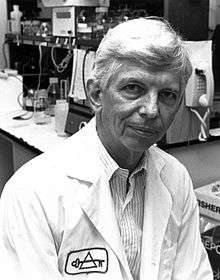Alfred G. Knudson
Alfred George Knudson, Jr. (August 9, 1922 – July 10, 2016) was an American physician and geneticist specializing in cancer genetics. Among his many contributions to the field was the formulation of the Knudson hypothesis in 1971,[1] which explains the effects of mutation on carcinogenesis (the development of cancer).[2][3]
Alfred Knudson | |
|---|---|
 | |
| Born | Alfred George Knudson, Jr. August 9, 1922 |
| Died | July 10, 2016 (aged 93) Philadelphia, Pennsylvania, U.S. |
| Nationality | United States of America |
| Alma mater | California Institute of Technology, Columbia University, California Institute of Technology |
| Known for | Knudson hypothesis |
| Awards | William Allan Award (1991) Lasker award (1998) Kyoto Prize (2004) |
| Scientific career | |
| Fields | Genetics, Medicine |
| Institutions | Fox Chase Cancer Center |
| Thesis | Histidine metabolism in liver (1956) |
| Doctoral advisor | Henry Borsook |
Early life and education
Knudson was born in Los Angeles, California in 1922. He received his B.S. from California Institute of Technology in 1944, his M.D. from Columbia University in 1947 and his Ph.D. from California Institute of Technology in 1956.[2] He held a Guggenheim fellowship from 1953 to 1954.[3]
Career and research
From 1970 to 1976, Knudson served as the Dean of Graduate School of Biomedical Sciences, University of Texas Health Science Center at Houston in the Texas Medical Center. He was affiliated with Fox Chase Cancer Center in Philadelphia from 1976 until his death in 2016.[4]
Knudson is best known for his "two-hit hypothesis," explaining the incidence of hereditary cancers, such as retinoblastoma.[1] Humans inherit two copies of every gene, one from each parent (except for genes on the X and Y chromosomes in males). Some people inherit one mutated version and one normal version of the retinoblastoma gene, which produces the retinoblastoma protein involved in controlling cell cycle progression. The inherited mutation is "the first hit." Over time, a mutation may arise in the normal version in one cell, thus producing "the second hit," which leaves the cell unable to control the process of cell division in an orderly manner, leading to cancer.
Knudson's insight was to compare the incidence of retinoblastomas, including the number of tumors, the ages of occurrence, and whether tumors occurred in both eyes, among children in families with and without hereditary predisposition to retinoblastomas. Children in families with a hereditary predisposition have more tumors at a younger age and usually have tumors in both eyes. Children in families without the hereditary predisposition usually have only one tumor at a later age.
The differences in occurrence can be explained by the rate of gene mutation during cell division (a somatic mutation), and a model that requires only one somatic mutation per tumor in hereditary cases but requires two somatic mutations, one on each copy of a particular cell cycle control gene, in one cell lineage in non-hereditary cases, i.e. the co-occurrence of two rare events. Knudson subsequently showed that the model was not only applicable to retinoblastoma but also to Wilms' tumors of the kidney.[5] These studies led to the concept of tumor suppressor genes, which Knudson called "anti-oncogenes."[6]
Honors and awards
He received numerous prizes and honorary doctorates for his work, most prominently the 1998 Albert Lasker Award for Clinical Medical Research.[7] He also received the 1999 American Society of Pediatric Hematology/Oncology (ASPHO) Distinguished Career Award, the 2005 American Association for Cancer Research (AACR) Award for Lifetime Achievement in Cancer Research, and the 2004 Kyoto Prize in Life sciences.[8]
Personal life
After a long illness, Knudson died on July 10, 2016 at the age of 93 at his home in Philadelphia .[9][3]
References
- Knudson, Alfred (April 1971). "Mutation and cancer: statistical study of retinoblastoma". Proceedings of the National Academy of Sciences of the United States of America. 68 (4): 820–3. doi:10.1073/pnas.68.4.820. PMC 389051. PMID 5279523.
- Lewis EB (December 2003). "A tribute to Alfred G. Knudson". Genes Chromosomes Cancer. 38 (4): 292–3. doi:10.1002/gcc.10251. PMID 14566845.
- Croce, Carlo M. (2016). "Alfred G. Knudson (1922–2016) Cancer geneticist whose insights launched the search for tumour-suppressor genes". Nature. London: Springer Nature. 536 (7617): 397. doi:10.1038/536397a. PMID 27558057.
- "Knudson's "Two-Hit" Theory of Cancer Causation. Fox Chase Cancer Center - Philadelphia, PA". www.foxchase.org. Retrieved 11 July 2016.
- Knudson, AG; Strong, LC (February 1972). "Mutation and cancer: a model for Wilms' tumor of the kidney". Journal of the National Cancer Institute. 48 (2): 313–24. doi:10.1093/jnci/48.2.313. PMID 4347033.
- Knudson, AG (1 December 1993). "Antioncogenes and human cancer". Proceedings of the National Academy of Sciences of the United States of America. 90 (23): 10914–21. doi:10.1073/pnas.90.23.10914. PMC 47892. PMID 7902574.
- "Tumor suppressor genes as a cause of cancer". The Lasker Foundation.
- "Kyoto Prize, Inamori Foundation". Kyoto Prize, Inamori Foundation.
- Susan Snyder (July 10, 2016). "Acclaimed Fox Chase geneticist dies at 93". Philly.com. Retrieved July 10, 2016.
External links
| Wikimedia Commons has media related to Alfred G. Knudson. |